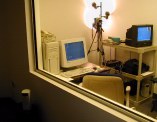danbricklin.com/log
|
|
|
|
A Ballot Usability Test
|
There is a report going around about second-graders being asked to fill in a ballot "similar" to the Palm Beach one I discussed on "Ballot Usability in Florida". This report is being publicized with headlines like "Butterfly Ballot a Cinch for Ga. Second-Graders".
A school psychologist asked 74 eight-year old children to vote for their favorite Disney characters. Unlike the Palm Beach ballot, this one was on one page not two, with no split down the middle. The arrows were larger than the Palm Beach ones. The only instructions were "Check the box for the one you choose."
Low and behold, all of the kids (when asked to evaluate their own ballot) checked the one they "intended". None made a mistake. Of the 74 kids, 71 marked their ballot "correctly" by checking or filling in the box, and 3 circled their answers.
The story is written like it is making fun of the grown-ups in Florida, but what do we learn from it? How does it relate to the Palm Beach situation?
In Florida, there are statistics that could be interpreted as saying 0.75% of the ballots were marked for the wrong person. Here, with larger arrows and no alignment problems in relation to punch holes, you'd expect a lower error rate -- let's guess about 10% -- giving us around 0.1% expected error rate if it was related. Since we only have 74 kids, the chances of them making a similar mistake would be low. Anyway, we don't know if it was just the arrows, or if it was the lines or the alignment or who knows what else that caused any given error. We don't know if it was just the two columns and arrows.
In Florida, a little over 4% of the ballots were marked incorrectly. Here, also 4% marked them incorrectly. Pretty remarkable coincidence (or is that why the story was publicized?).
You can't really tell just from people's behavior why they make mistakes, though you can get some clues. By asking them why they do things and what they are thinking, you can understand more. Usability testing lets you do all that. You get to see things from their perspective. Watching them from behind a one-way mirror you see how reasonable mistakes can be and how hard it is to design something that everybody can use.
You can learn more about usability testing by reading articles listed on the UsableWeb.com site, such as those on the "What is Usability Testing?" page.
 This is the lab Trellix uses to test software, viewed through the one-way mirror. For more information, see my April 6th log entry "Behind the one-way mirror".
|
|
|
© Copyright 1999-2018 by Daniel Bricklin
All Rights Reserved.
|